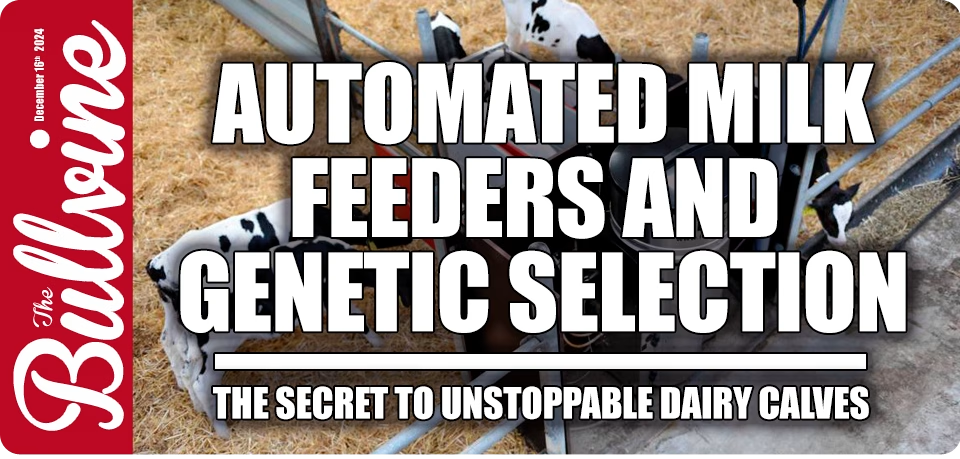Latest News
Canadian Milking Shorthorn Society Honors Record-Breaking Production Champions
See how Canadian Milking Shorthorns are setting new production records. What drives these cows to succeed? Discover their impact on the dairy industry. Summary: […]Milk Crisis: Analyzing the Bird Flu Impact on California’s Dairies
Bird flu is transforming California's dairy sector. Will farmers overcome these obstacles and find new opportunities? Summary: The avian influenza outbreak has […]Mexico: America’s Top Dairy Ally
Why is Mexico the top market for U.S. dairy? How does this demand affect American farmers and exports? Uncover the future of this critical trade partnership. Su […]European Dairy Future: Navigating Long-Term Milk Volume Decline and Market Shifts
How will falling milk volumes and regulations shape EU dairy's future? Uncover the impact on your strategy now. Summary: The European Union is pivotal as&n […]How the Government Shutdown Threatens Dairy Farmers and the USDA: What You Need to Know
Explore the looming government shutdown's effects on dairy farmers and USDA. What can you expect, and how can you prepare? Summary: The looming […]
More News
- New Zealand Leads Global Charge in Methane Reduction: Insights from the Latest Dairy Innovations
- How SwagBot, the AI-Powered Robot, is Transforming Cattle Herding and Preventing Soil Degradation
- California’s Dairy Shock: November 2024 US Milk Production Report & Market Impact
- California Declares State of Emergency: Bird Flu Threatens Dairy Farms Across the State
- The Grinch’s Effect: Milk Prices Plummet Amid Dairy Market Turmoil
- Lactanet’s LPI April 2025 Update: What It Means for Dairy Farmers
- Charlie Will Receives CentralStar Cooperative Pioneer Award
- World Dairy Expo Accepting Nominations for 2025 Recognition Awards
- Dairy Outlook December 2024: Navigating Price Shifts and Production Trends in a Competitive Market
- Argentina’s Dairy Revival: Analyzing the Production Surge and Economic Rebound
Top News Posts from Past Week
- Oakfield Solomon Footloose Named 2024 World Dairy Expo Grand Champion
- Meet the 2025 World Dairy Expo Judges
- California’s Dairy Shock: November 2024 US Milk Production Report & Market Impact
- Lactanet’s LPI April 2025 Update: What It Means for Dairy Farmers
- Unraveling the Misinformation: Bill Gates, Bovaer, and the Future of Dairy Farming
- Will RFK Jr.’s Influence Ignite a Raw Milk Revolution in America?
- The Grinch’s Effect: Milk Prices Plummet Amid Dairy Market Turmoil
- Michigan Farm Forced to Destroy Raw Dairy Products Amid Violations of State Laws
- Top 10 Best Places to Farm in the U.S. Revealed by 20-Year USDA Study
- US Milk Output Drops Yet Again: Heifer Shortage and Bird Flu Impact Supply and Prices
Feature Articles
Feed to Win: How to Maximize Your Dairy Show Heifers Potential
Unleash your show heifer's full potential. Optimize feeding strategies for their success in the show ring. Explore practical insights for superior performance.& […]How a Trump Presidency Could Transform America’s Dairy Industry: Opportunities and Challenges for 2025 and Beyond
How will Trump's presidency reshape the US dairy industry? What challenges and opportunities await dairy farmers in 2024 and beyond? E96 How a Trump Presidency […]Eggnog Overload? Discover Why Cheddar is the Perfect Holiday Remedy
Feeling the eggnog blues? See how cheddar can save your holiday. This cheese is the ultimate fix for dairy fans this season. E95 Eggnog Overload? Discover Why C […]Dairy Farmer Christmas Wishlist 2025
Explore the perfect Christmas gifts for dairy farmers. What adds cheer to their holidays? Check our expert guide for thoughtful ideas. E94 Dairy Farmer Christma […]Unlocking the Power of Data: How AI is Revolutionizing Dairy Farming and Why You Should Own Your Data
See how AI transforms dairy farming and why owning your data is key for productivity and informed decisions. Ready? E93 Unlocking the Power of Data: How AI is R […]
More Articles
- How Dairy Farmers Profit from Strong Beef Prices Amid Historic Highs
- Automated Milk Feeders and Genetic Selection: The Secret to Unstoppable Dairy Calves
- Sire Summaries Simplified: A Dairy Farmer’s Guide to U.S. Genetic Evaluations
- From Milk Machines to Component Champions: How Genomics and Sexed Semen Are Remaking the Dairy Cow
- Why 2025 Could Be the Most Profitable Year for Dairy Farmers Yet!
- Gamifying Cow Handling: How a Smartphone App is Revolutionizing Dairy Farm Training
- Sabbiona Holsteins: Where Genetics and Passion Forge Dairy Champions
- Bovaer Unleashed: The Controversial Additive Changing Dairy Forever
- Sustainable Dairy Farming: Revolutionizing Practices for a Greener, Profitable Future
- Choosing the Right Robotic Milking System: Brands, Experiences, and Future Preferences
Top Feature Articles from the Past Month
- The Royal Winter Fair 2024 – Holstein
- International Holstein Show 2024
- The Royal Winter Fair 2024 – Red & White Holstein
- Ontario Summer Holstein Show 2024
- Jersey vs. Holstein: Which Dairy Breed Delivers Greater Profitability for Farmers?
- TD Canadian 4-H Dairy Classic
- Emulating Ryan Rash: The Dire Need for Revolutionizing Dairy Cattle Judging Standards
- Le Supreme Dairy Show – Holsteins 2024
- How Huronia Centurion Veronica 20J Redefined the Jersey Breed
- The Royal Winter Fair 2024 – Jersey
- Feed to Win: How to Maximize Your Dairy Show Heifers Potential
-
Feed to Win: How to Maximize Your Dairy Show Heife…
Andrew Hunt Dec 22, 2024Unleash your show heifer's full potential. Optimize feeding strategies for their success in the show ring. Explore practical insights for superior performance. E97 Feed to Win: How to Maximize Your Dairy Show Heifers Potential Are Your Show Heifers Reaching Their Potential? The ans… Read More - How a Trump Presidency Could Transform America's Dairy Industry: Opportunities and Challenges for 2025 and Beyond
-
How a Trump Presidency Could Transform America’s D…
Andrew Hunt Dec 21, 2024How will Trump's presidency reshape the US dairy industry? What challenges and opportunities await dairy farmers in 2024 and beyond? E96 How a Trump Presidency Could Transform America’s Dairy Industry: Opportunities and Challenges for 2025 and Beyond The American dairy industry isn'… Read More
- Eggnog Overload? Discover Why Cheddar is the Perfect Holiday Remedy
-
Eggnog Overload? Discover Why Cheddar is the Perfe…
Andrew Hunt Dec 20, 2024Feeling the eggnog blues? See how cheddar can save your holiday. This cheese is the ultimate fix for dairy fans this season. E95 Eggnog Overload? Discover Why Cheddar is the Perfect Holiday Remedy Imagine this: holiday lights twinkling, the smell of pine filling the air, and glasses of eggnog… Read More
- Dairy Farmer Christmas Wishlist 2025
-
Dairy Farmer Christmas Wishlist 2025
Andrew Hunt Dec 19, 2024Explore the perfect Christmas gifts for dairy farmers. What adds cheer to their holidays? Check our expert guide for thoughtful ideas. E94 Dairy Farmer Christmas Wishlist 2025 As the sun rises over snowy fields and turns the farm into a golden landscape, winter wraps its peaceful embrace arou… Read More
- Unlocking the Power of Data: How AI is Revolutionizing Dairy Farming and Why You Should Own Your Data
-
Unlocking the Power of Data: How AI is Revolutioni…
Andrew Hunt Dec 18, 2024See how AI transforms dairy farming and why owning your data is key for productivity and informed decisions. Ready? E93 Unlocking the Power of Data: How AI is Revolutionizing Dairy Farming and Why You Should Own Your Data Data is the new currency of contemporary dairy production. Today's farm… Read More
- How Dairy Farmers Profit from Strong Beef Prices Amid Historic Highs
-
How Dairy Farmers Profit from Strong Beef Prices A…
Andrew Hunt Dec 17, 2024Explore how dairy farmers benefit from high beef prices. Are you optimizing profits with crossbred calves? Discover strategies to enhance your income. E92 How Dairy Farmers Profit from Strong Beef Prices Amid Historic Highs Are you ready to deal with the unpredictable changes in the price of… Read More
- Automated Milk Feeders and Genetic Selection: The Secret to Unstoppable Dairy Calves
-
Automated Milk Feeders and Genetic Selection: The…
Andrew Hunt Dec 16, 2024Explore how automated milk feeders and genetic selection enhance calf resilience. Ready to unlock your herd's potential? E90 Automated Milk Feeders and Genetic Selection: The Secret to Unstoppable Dairy Calves Dairy farming is a key part of agriculture, facing changes due to climate shifts an… Read More
- Sire Summaries Simplified: A Dairy Farmer’s Guide to U.S. Genetic Evaluations
-
Sire Summaries Simplified: A Dairy Farmer’s Guide…
Andrew Hunt Dec 15, 2024Unlock the U.S. genetic system. Make smarter breeding choices and improve your herd's productivity. Ready? E89 Sire Summaries Simplified: A Dairy Farmer’s Guide to U.S. Genetic Evaluations Understanding the U.S. genetic system empowers you to make better breeding decisions. This knowledg… Read More
- From Milk Machines to Component Champions: How Genomics and Sexed Semen Are Remaking the Dairy Cow
-
From Milk Machines to Component Champions: How Gen…
Andrew Hunt Dec 14, 2024Explore how genomics and sexed semen are turning dairy cows into component giants. Ready to rethink milk's future? E88 From Milk Machines to Component Champions: How Genomics and Sexed Semen Are Remaking the Dairy Cow For years, the dairy industry was primarily focused on producing… Read More
- Why 2025 Could Be the Most Profitable Year for Dairy Farmers Yet!
-
Why 2025 Could Be the Most Profitable Year for Dai…
Andrew Hunt Dec 13, 2024Discover how record dairy investments will transform the industry. Will U.S. farmers address global demand challenges and seize opportunities? E87 Why 2025 Could Be the Most Profitable Year for Dairy Farmers Yet! As trade and the economy around the world change quickly, the US dairy industry… Read More
Tanbark Trail
Is Erbacers Snapple Shakira One of the Greatest Show Cows of All Time?
Uncover why Erbacres Snapple Shakira stands among the top dairy show cows of all time. What makes her excel in the competitive dairy arena? E55 Is Erbacers Snapple Shakira One of the Greatest Show Cows of All Time? From the moment she steps into the […]The Royal Winter Fair 2024 – Jersey
Judge Jeff Sales NTENSE JOEL DELPHIE ETGrand ChampionThe Royal - Jersey Show 2024WEEKSDALE/HI-CALIBER/ROCK ALLEN/F&D BORBA, BREADALBANE, PE c LEACHLAND VIDEO MOCHA K Intermediate Champion The Royal - Jersey Show 2024 WEEKSDALE HOLSTEINS, BRE […]The Royal Winter Fair 2024 – Holstein
Judge Blair Weeks JEFFREY-WAY HARD ROCK TWIGS Grand Champion The Royal - Holstein Show 2024 K. DOEBERIENER, L. BOWEN & PAT CONROY, R&F LIVESTOCK INC, & WALKER DAIRY INC. Grand Champion: Jeffrey-Way Hard Rock Twigs, 1st 4-year-old, K Doebe […]The Royal Winter Fair 2024 – Red & White Holstein
November 4th 2024 Judge: Markus Hehli, Rimbey, AB PREMIUM APPLE CRISP LILLY Grand Champion The Royal - Red & White Holstein Show BUTLERVIEW FARM, CHEBANSE, IL Grand Champion: Premium Apple Crisp Lilly (Apple-Crisp), 1st 5-year-old, Butlerview Far […]TD Canadian 4-H Dairy Classic
November 4th 2024 Judge: Curtis McNeil, ON JUNIOR SHOWMANSHIP, 12-14 years old McKenzie Howard, Burgessville, ONHODGLYNN ACTIONMAN HARISSA, HOCANF14971465 Emily Smygwaty, Russell, ONKINGSWAY WARRIOR LOOKOUT, HOCANF14798896 Alyson […]
The Bullvine LLC © 2024 | Terms of Use | Community Guidelines | Privacy Policy |
Manage Consent
To provide the best experiences, we use technologies like cookies to store and/or access device information. Consenting to these technologies will allow us to process data such as browsing behavior or unique IDs on this site. Not consenting or withdrawing consent, may adversely affect certain features and functions.
Functional Always active
The technical storage or access is strictly necessary for the legitimate purpose of enabling the use of a specific service explicitly requested by the subscriber or user, or for the sole purpose of carrying out the transmission of a communication over an electronic communications network.
Preferences
The technical storage or access is necessary for the legitimate purpose of storing preferences that are not requested by the subscriber or user.
Statistics
The technical storage or access that is used exclusively for statistical purposes.
The technical storage or access that is used exclusively for anonymous statistical purposes. Without a subpoena, voluntary compliance on the part of your Internet Service Provider, or additional records from a third party, information stored or retrieved for this purpose alone cannot usually be used to identify you.
Marketing
The technical storage or access is required to create user profiles to send advertising, or to track the user on a website or across several websites for similar marketing purposes.






























